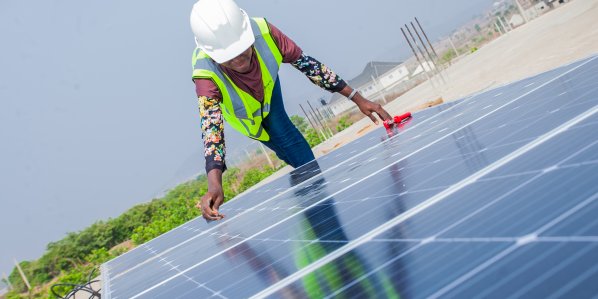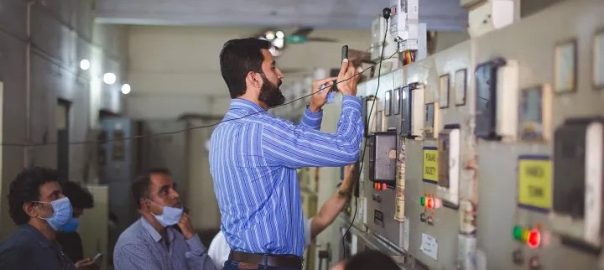
Last year at the 26th UN Climate Change Conference, USAID committed to partnering with countries to reduce, avoid, or sequester at least six billion metric tons of global greenhouse gas (GHG) emissions by 2030. Preventing six billion metric tons of GHG emissions is the equivalent of taking 100 million cars off roads for a decade, or roughly the amount of GHG emissions the United States emits each year. After making the commitment, USAID then codified it as one of its six ambitious goals in the Agency-wide 2022-2030 Climate Strategy.
The energy sector as a whole presents an opportunity to achieve this goal, as 75% of global emissions come from electricity generation and the consumption of fossil fuels in transportation, industry, and buildings. Decreasing emissions from the energy sector without stifling economic growth will require huge investments in developing countries in particular, whose energy consumption will almost double by 2050 and will by then represent a majority of global energy emissions. USAID supports partner countries’ efforts to power economic growth in a clean manner by helping them transition from fossil fuels to renewable energy, improve energy efficiency, and mobilize finance for investment in clean energy solutions. Read more for further insight on these and other approaches in USAID’s work.
Increasing Utility Performance and Modernizing Grids through Renewables and Technology
Now more than ever, transitioning away from fossil fuels to clean, reliable, renewable energy is essential for mitigating climate change and supporting sustainable development. Between 2011 and 2020, USAID’s energy programs contributed to the installation of more than 189,000 megawatts of renewable capacity across 20 focus countries. The 2022-2030 Climate Strategy prioritizes continuing support for the integration of renewables into the electricity grid, reducing reliance on fossil fuels for power generation, and expanding and strengthening electricity grids using advanced smart-grid technologies.
As global climate change impacts intensify, helping partners find new and efficient ways to promote and invest in clean, renewable energy is critical to increasing nations’ energy security. USAID’s Kosovo Energy Security of Supply (KESS) Activity is working on the cutting edge of renewable technology. The activity assesses which areas in a town have the greatest potential for solar energy generation by using drones to photograph rooftops, processing photos into 3D information, and using Geospatial Information System tools to calculate the amount of solar radiation each rooftop receives. Since October 2021, USAID KESS has surveyed and assessed 260 businesses, 60 state-owned facilities, and more than 500 households across Kosovo, identifying one million square meters of viable rooftop space for solar photovoltaic installation. By making this data readily available to the public, USAID is helping promote solar uptake. USAID estimates that the businesses and households assessed will be able to install approximately 100 megawatts of solar capacity—equal to annually powering 24,000 Kosovan households.
Bolstering Energy Efficiency
Energy efficiency is central to reducing GHG emissions and to also meeting the global energy demand. According to the International Energy Agency (IEA), energy efficiency measures—like improving the building envelopes that separate the interior and exterior of a building and making sure that all new appliances that are brought to market are the most efficient models available—play a key role in limiting the rise in electricity demand in a net-zero emissions world. Without these measures, electricity demand in buildings would be around 10,000 terawatt hours higher by 2050, or around 70 percent higher than the level needed to reach net-zero emissions.
To this end, USAID, through its Market Integration and Transformation for Energy Efficiency (MAITREE) program, supported the Government of India’s large-scale energy efficiency efforts by partnering with public and private agencies, supporting the design and deployment of super-efficient air conditioners. To date, USAID has helped its partners in India retrofit more than 11,000 buildings with equipment like LED lights, energy-efficient ceiling fans and motors, and super-efficient air-conditioners. USAID also has helped its partners in India procure more than 100,000 energy-efficient air conditioners and avoid 74,000 tons of GHG emissions.
Mobilizing Finance for the Electric Power Sector
Decreasing energy sector emissions will require large financial investments in developing countries, the bulk of which will have to come from the private sector. Between 2011 and 2020, USAID’s renewable energy programs helped facilitate more than $225 billion in private investment for wind, solar, and other renewables, creating 189,000 megawatts of renewable energy capacity in 20 focus countries.
Through INVEST, an Agency-wide initiative to mobilize private capital for development, USAID is testing a range of approaches to climate finance as it seeks to catalyze private sector funding toward better development outcomes. As of September 2021, USAID and INVEST have mobilized $112.5 million from the private sector for renewable energy and the circular economy, and they are projected to mobilize $327 million for climate action by 2025.
USAID and INVEST are deploying these models of support to fill the gaps left by traditional public funding and to reduce GHG emissions in developing and emerging nations like Kenya, Mozambique, and Colombia. They’re doing this by supporting Power Africa’s effort to expand off-grid energy access in Kenya, the ThirdWay Africa Rural Development Corporation’s push for a permanent climate capital vehicle in Mozambique, and Colombia Energy for Peace’s expansion of sustainable solar mini-grids..
Expanding Access to Reliable Electricity
According to the IEA, 770 million people throughout the world lack access to reliable electricity. USAID’s energy programs work in partner countries to expand access to affordable, reliable, and sustainable energy services, and the Agency’s Climate Strategy places special emphasis on using renewable energy grid solutions to reach people without energy access and to electrify households while avoiding or mitigating future emissions.
Power Africa is a U.S. Government-led, USAID-coordinated partnership that brings together the collective resources of more than 170 public and private sector partners to double access to electricity in sub-Saharan Africa. Power Africa’s goal is to add at least 30,000 megawatts of cleaner and more reliable electricity generation capacity and 60 million new home and business connections by 2030. In Fiscal Year 2021, Power Africa:
- Added 1,329 megawatts of new electricity − 95 percent from renewable sources − from 24 power projects to turn on lights across the continent.
- Electrified more than 220 health facilities in nine countries through a $2.8 million grant initiative that rewarded sustainable business models from private sector off-grid energy companies.
- Delivered first-time electricity access to 39.7 million people through 8.1 million new on- and off-grid connections to homes and businesses.
- Avoided 6.2 million tons of CO2 emissions, the equivalent of burning 6.8 billion pounds of coal.
Decarbonizing Energy for Transportation
USAID works with country partners to develop sustainable transportation systems, including greater production and use of electric vehicles (EVs), and it assists with planning and analysis to develop green hydrogen and other alternative fuels for decarbonization of the electric power industry, and other sectors.
Earlier this year, USAID partnered with VEGA Innovations, a Sri Lankan electric vehicle manufacturer, to support their efforts to promote the adoption of EVs, including electric “tuk tuks,” or motorized rickshaws. Through this collaboration, USAID will also help VEGA Innovations pilot a charging network for EVs and manufacture locally designed batteries and inverters to expand Sri Lankan EV adoption. By increasing the amount of EVs on roads, USAID and its partners will reduce fossil fuel consumption and ultimately reduce GHG emissions.
By continuing to work across these priorities and others – such as energy policy, energy planning, competitive procurement, utility management, utility reform, regional power trade, and social equity, justice, and inclusion, to name a few — USAID will help our partner countries build sustainable, resilient systems and transition to clean and reliable power, all while staying on track to reach the six billion ton GHG emission reduction goal

